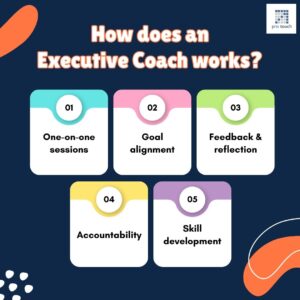An Executive Coach is a professional who works with leaders, executives, and high-potential professionals to help them enhance their leadership skills, decision-making, self-awareness, and overall performance.
Think of them as a strategic partner rather than a boss or trainer — they don’t tell leaders what to do, but help them think more clearly, act more effectively, and grow more intentionally.
In short — an executive coach doesn’t “fix” you; they unlock your best leadership self, so you can perform at your peak and help your team thrive.
Here’s how it usually works:

Executive Coach
- One-on-one sessions: Confidential conversations tailored to the leader’s goals and challenges. Personalized attention – The sessions are private and focused only on the leader’s unique challenges and goals. Safe & confidential space – Leaders can speak openly about struggles they may not share with colleagues or superiors. Structured conversations – The coach uses questions, frameworks, and feedback tools to help the leader reflect and gain clarity. Goal-driven – Each session is tied to specific leadership objectives (e.g., improving delegation, handling conflict, or building executive presence). Action-oriented – Sessions usually end with clear next steps, practices, or strategies to apply in the workplace. Ongoing progress check – Future sessions revisit these goals to track growth and make adjustments. One-on-one sessions are customized coaching journeys designed to help leaders become more effective, confident, and impactful.
- Goal alignment: in executive coaching means ensuring that the leader’s personal development objectives are in sync with the organization’s strategic priorities. It focuses on both personal growth (e.g., confidence, communication, emotional intelligence) and organizational objectives. Clarifying the leader’s aspirations – Understanding what they personally want to improve (e.g., decision-making speed, influencing skills). Linking to business objectives – Connecting these personal goals to what the company needs (e.g., driving a change initiative, improving cross-functional collaboration). Defining measurable outcomes – Agreeing on what success will look like for both the leader and the organization. Balancing personal and organizational needs – Making sure growth benefits both the individual and the business, without one overshadowing the other. Creating a shared commitment – Leader, coach, and sometimes key stakeholders agree on the priorities and the path forward. It’s basically about making sure the leader’s growth fuels the company’s success—not just one or the other.
- Feedback & reflection: in executive coaching is all about helping leaders see themselves more clearly so they can make intentional changes. Use tools like 360° feedback, assessments, and observation to build self-awareness. Gathering feedback – Using tools like 360° assessments, stakeholder interviews, or performance reviews to capture multiple perspectives on the leader’s strengths and blind spots. Holding up the mirror – The coach presents this feedback in a constructive, non-judgmental way, helping the leader understand how they’re perceived. Encouraging self-reflection – Through thought-provoking questions and exercises, the leader examines their behaviors, decisions, and impact. Spotting patterns – Identifying habits or mindsets that either support or hinder effectiveness. Turning insight into action – Reflection isn’t just thinking—it’s about deciding what to keep doing, start doing, or stop doing. In short, feedback shows the picture, reflection sharpens it, so the leader can act with greater clarity and confidence.
- Accountability: Keep the leader on track with agreed-upon actions. Accountability in executive coaching ensures that leaders don’t just talk about change—they actually follow through. Clear commitments – At the end of each session, the leader defines specific actions they’ll take before the next meeting. Regular check-ins – The coach reviews progress, asks what worked, and explores what got in the way if goals weren’t met. Encouraging ownership – The leader takes responsibility for their own growth rather than blaming circumstances. Celebrating progress – Recognizing even small wins keeps motivation high. Adjusting course – If something isn’t working, the coach helps refine strategies instead of letting momentum fade. In essence, accountability is the bridge between intention and impact—it turns coaching insights into measurable results.
- Skill development: in executive coaching focuses on building the specific leadership capabilities a leader needs to excel in their role and future responsibilities. It improves leadership competencies such as conflict resolution, strategic thinking, or managing change. Identifying priority skills – Pinpointing gaps based on feedback, self-assessment, and organizational needs (e.g., strategic thinking, emotional intelligence, negotiation). Practical learning – Using real workplace challenges as “practice fields” rather than purely theoretical exercises. Behavioral modeling – The coach may demonstrate techniques or share frameworks the leader can apply immediately. Stretch assignments – Encouraging leaders to take on tasks or projects that push them beyond their comfort zone. Ongoing refinement – Revisiting skills over time to strengthen mastery and adaptability. Put simply, it’s about equipping leaders with the right tools in the right moments so they can lead with greater impact and confidence.
Conclusion
Executive coaching is more than a leadership “tune-up” — it’s a structured, confidential partnership that helps leaders unlock their full potential while driving organizational success. Through one-on-one sessions, clear goal alignment, honest feedback & reflection, targeted skill development, and consistent accountability, leaders gain the clarity, confidence, and capability to navigate complex challenges and inspire their teams. Courses like ICF Certification, ICF Coach Training can help to become an Executive Coach.
When done well, executive coaching creates a ripple effect — the leader grows, their team thrives, and the organization as a whole becomes stronger, more agile, and better positioned for long-term success.





Leave a Reply